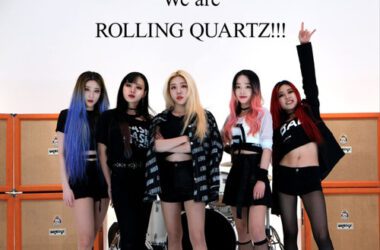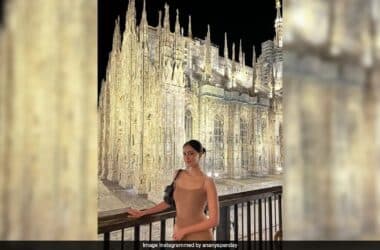As three people struck wood with mallets under a viaduct in Queens during the morning rush hour one day in the fall, a man walked up and asked, “What do you call this music?” The players could have told him the title of the piece, Michael Gordon’s “Timber,” or given him some idea of the genre. But one, Caitlin Cawley, simply said, “Percussion.”
Cawley and her colleagues from the ensemble Mantra Percussion were at the viaduct, which runs along Queens Boulevard and under the 7 train, to test the sound of its vaulted ceiling. It was part of a project to perform “Timber,” an hourlong work from 2009, in man-made sites with idiosyncratic acoustics around New York City.
The result, called Resonant Spaces, begins on Sunday, with performances at three locations, followed by three more on April 21. In addition to the viaduct, they include Castle Clinton and Federal Hall in Lower Manhattan, and in Brooklyn, archways in Prospect Park and Dumbo, and a monument in Fort Greene Park. The free concerts will allow the public to hear New York the way percussionists do: as a limitless source of musical opportunity.
“Timber” was originally written for the Dutch group Slagwerk Den Haag. Six percussionists struck amplified two-by-fours — a take on simantras, planks of wood shaped to create specific tones, which have a history of being used in the Eastern Orthodox Church.
In the early performances of “Timber,” the simantras were made from pine, but Mantra Percussion has taken a different route. Michael McCurdy, a member, said that the score didn’t specify the wood. “When you are learning Xenakis, or anything,” he said, “when the composer says ‘wood block,’ the variety of sounds that can come from that instrument is vast.’”
For Resonant Spaces, “Timber” will be played with purpleheart — a wood so dense, McCurdy said, that the Mantra players exhausted and had to replace a circular saw for cutting the pieces. On that fall morning, he, Cawley and Joseph Bergen carried their boards and other equipment from location to location, on the subway and in rideshare cars, as they tested sites for the concerts to see where the piece would thrive.
They allowed me to join with a photographer, and to record audio at each stop.
Queens Boulevard Viaduct
Gordon described the viaduct’s grandly arched space as “really acoustically wild, almost fantastic.” As the players tested fragments of “Timber,” the sound ricocheted off the ceiling, shooting in all directions.
They tried different configurations — setting up their mounted boards close together, or far apart, in the center of the vaulted space or at the edge of it — as passers-by stopped to listen or interact with them. One woman wanted to give Cawley some cash.
Gordon was curious about a spot near the subway entrance, with a lower, flat ceiling. The sound wasn’t as spectacular, but the performance still caught the attention of a man who said with astonishment: “It’s wood. I’m walking over here wondering what’s going on, but it’s just wood. That’s astounding.”
After a brief pause, Gordon looked at him and, like any good New Yorker, said, “You know that you’re wearing a Red Sox hat, right?”
Endale Arch
After a car ride from Queens, the group arrived at the entrance of Prospect Park, and walked to the Endale Arch. The short tunnel, strikingly lined with alternating panels of pine and walnut, is one of the original architectural features from the park’s creation more than 150 years ago.
Under the arch, while runners, confused and frightened dogs, and school groups passed, Gordon and the Mantra players tried the most configurations of any location they visited that day. They found that the sound could be severe, but better if they let it reflect off one of the tunnel’s brick nooks, and best if they spaced out the instruments, especially at either entrance. McCurdy smiled as he asked the others whether they could hear overtones emerging from the resonance.
“It was a little harsh and loud,” Gordon said of the space. “It was amplifying the sound and also bringing out the bright overtones.” Milder, he added, was an area of Fort Greene Park in front of the Prison Ship Martyrs’ Monument, where the Mantra musicians had previously played “Timber.” (They will be back there on April 21). “That,” Gordon said, “is not particularly loud or reverberant, but it’s much more subtle and kind of beautiful.”
Federal Hall
The group then hauled its equipment onto the 2 train, getting out at the Wall Street stop to test the rotunda of Federal Hall, the first home of the U.S. Congress and the site of George Washington’s swearing in as president.
On the way, the percussionists played in the subway exit — a tinny corridor lined with tile — as well as in Kevin Roche’s postmodern lobby of 60 Wall Street (now closed for renovation and likely demolition), before arriving at Federal Hall. There was a school group visiting, and the children began to gather around the trio as they played. Afterward, the students asked to try for themselves, and took turns striking the wood.
Of the day’s stops, the rotunda was the most naturally reverberant. “It was so thick with reverb and delay that you could hardly make out what they were playing,” Gordon said. “The distinction was almost completely lost. The sound is bouncing off the walls and off the floor, and it just doesn’t stop. You’re just really drenched in sound.”
Bethesda Terrace
From there, it was back to the subway and up to the Upper West Side for a stop at Central Park, where the musicians made their way to the arcade under Bethesda Terrace. When they arrived, they had competition, not so much from the wedding party shuffling around for a photo shoot or the children’s entertainer making large bubbles, but from other musicians: Cover Story Doo-Wop, an ensemble of four vocalists and a bass player that had attracted a large audience.
But after being offered cash and cutting a deal for the Mantra players to be quick, Cover Story took a break and stood the side while the percussionists set up their instruments and got started. This heavily trafficked area of the park offered the most passers-by yet, but also the most indifferent ones; few stopped to listen, and no one stopped for conversation.
Gordon and the Mantra musicians decided not to perform in Central Park. It seemed chaotic, Gordon said, and he got the impression that they “were not going to get the feeling or the focus of people who actually showed up and wanted to hear it.”
AFTER A DAY of hearing “Timber” around New York, Gordon said that he didn’t think the spaces materially changed the music. “The piece is the piece,” he said. “I think it’s less about what places do to the piece as what it does to our awareness of the spaces we walk through.”
That’s what audience members, those who plan to attend or those who stumble across the performances, could get out of Resonant Spaces. “Walking through the viaduct is a phenomenal experience,” Gordon said. “But it’s one we all have. We go to the park and walk through a tunnel. Central Park is full of them. These places aren’t hidden. But their acoustical properties — those kind of are.”
Source link












![billy woods / Kenny Segal: “FaceTime” [ft. Samuel T. Herring] 17 billy woods / Kenny Segal: “FaceTime” [ft. Samuel T. Herring]](https://talentsofworld.com/wp-content/uploads/2024/10/billy-woods-Kenny-Segal-FaceTime-ft-Samuel-T-Herring-380x250.jpg)